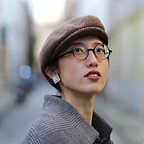10 Most Expensive Paintings in Paris during the Roaring Twenties — Part 1
Which one is your favorite?
Ernest Hemingway, wrote to a friend in the 1950s, reminiscing on the good old days in Paris during the Roaring Twenties:
If you are lucky enough to have lived in Paris as a young man, then wherever you go for the rest of your life, it stays with you, for Paris is a moveable feast.
The decade of the 1920s in Paris was referred to as “The Roaring Twenties”. Numerous writers, artists, and musicians were coming to Paris, making Paris a true crossroads of different cultures. Impressionists like Monet or post-impressionists like Gauguin or Van Gogh became already mainstream artists. Surrealism and Cubism were emerging as avant-garde movements. Foreign artists such as the Russian artist Chagall or the Japanese painter Foujita were also well-recognized; this group of independent foreign artists was named “The School of Paris”. In such a rich environment favored for artistic creations and collaborations, whose paintings were the most popular then?
See below the graph of the fifty most expensive paintings that cost more than 200,000 French francs during the 1920s (equals 15 million euros in 2020). Except for several works which realized more than 700,000 francs, most paintings were sold between 200,000 francs to 400,000, and most of them were works of Impressionists artists such as Claude Monet, Auguste Renoir, or Edgar Degas.
Now let’s take a look at the most expensive 10 paintings, from the least costly to the most valuable. Today we will talk about five artworks.
10th. Pulcinella by Édouard Manet: 420,000 Fr
This painting was bought by an art dealer Jos Hessel in 1926. Pulcinella is a character that emerged from the Italian comedy. In the Italian tradition, he usually dressed in a white suit of wide trousers, a tunic held up by a belt, and a pointed cap. His upper face was covered by a black mask. However, the French adaptation featured Pulcinella in colorful costumes, as we could see in Manet’s painting. Manet's friend Edmond André, a painter, posed for this painting. With his arms outstretched, his face towards us, this Pulcinella depicted by Manet was full of confidence. The contrast between the grey background and the colorful costume also makes the character more living.
9th. Bathers by Paul Cézanne: 475,000 Fr
This painting was equally bought by the art dealer Jos Hessel in 1927. Throughout his life, Cézanne painted more than ninety paintings and sketches on this subject. This painting featured in a wooded area patched by bleu and green dashes, a group of women were in different poses near the lake: some lying down, some taking off their clothes. These figures are part of a pyramidal composition delimited by two large trees in the background. Though this painting seems to be a study of other larger works, it is an independent work with rough touches. It is now conserved at the Art Institute of Chicago.
8th. Argenteuil by Claude Monet: 481,000 Fr
From 1871 to 1878, Monet lived with his family in Argenteuil, a commune in the northwestern suburbs of Paris. The beautiful scenery along the Seine attracted many Parisians visitors and it took only 15 minutes from the center of Paris. During his residence, Monet painted a series of views at the basin of Argenteuil. In this version, two red sailboats are at the center of the composition. On the left, a couple is standing on the bank and a sailer seems ready to set out. The sky is composed of different layers of subtle colors. Water’s surface is also painted by short and thick brushstrokes, a typical impressionist painting technique to capture the ever-changing effects of light in a landscape.
7th. The Injured Bather by Pierre-Auguste Renoir: 505,000 Fr
This painting was also bought by the art dealer Jos Hessel. Most of Renoir’s early works, such as Dance at Le moulin de la Galette, depicted the vivid modern life of Parisians.
But in his later years, there was a growing interest in the classical themes, and Renoir worked more on the subject of the female nude. This painting was created in 1909, shortly after Renoir moved to a village in the south of France. Looking relaxed, the woman is cleaning a wound with her white towel. The leaves behind suggest that she is in a forest where she took her bath. Soft brushstrokes make contours of the body more subtle as if dissolved in the deep forest. The smooth texture of the body also reflected Renoir’s experience working as a ceramic artist when he was a teenager.
6th. The Sleeping Gypsy by Henri Rousseau: 520,000 Fr
This painting was first bought by Irish-American lawyer John Quinn in 1926 from the Gallery Bing, and it was later acquired by Simon Guggenheim and donated to the Museum of Modern Art (MoMA) in New York. Rousseau, known as Le Douanier (the customs officer), is a self-taught painter in the Naïve style. Rousseau described his painting thus:
A mandolin player, lies with her jar beside her (a vase with drinking water), overcome by fatigue in a deep sleep. A lion chances to pass by, picks up her scent yet does not devour her. There is a moonlight effect, very poetic.
Indeed the setting is poetic but surreal: In a desert near a lake enclosed by mountains, the lion and the gypsy woman seem to be absorbed in their world. Beautiful silence between them. Shiny stars and moonlight in the deep blue sky are observers of this dreamlike scene.
Among these five paintings, my favorite is Rousseau’s The Sleeping Gypsy. I am sure that I could have a sweet dream with its company in my bedroom, like the gypsy woman in the picture.
And you? Which one will you like to bring into your home?
You could read Part 2 here:
References:
- Fage, André. Le Collectionneur de Peintures Modernes. Paris: Pittoresques, 1930.
- Online Catalogue Raisonné of Cézanne: https://www.cezannecatalogue.com/
